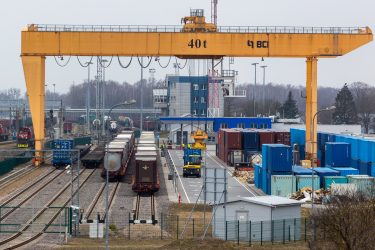Britain’s official crash scene investigators, the Rail Accident Investigation Branch (RAIB), has formally declared its interests in the recent freight derailment in Manchester. The RAIB is duty-bound to review all incidents on the UK network. Their team was on the scene at Audenshaw in Manchester, shortly after the significant derailment on 6 September. RailFreight.com has been given exclusive insight by the DB Cargo recovery team who are attending the wreck.
Work continues to recover the stranded aggregates train at Sidmouth Street bridge. The service came to grief on a short freight-only chord. The line, currently blocked, runs between Audenshaw Reservoirs and Ashton cricket ground. There is extensive damage to the infrastructure. The bridge over the otherwise quiet suburban street, has complicated the recovery job. It is proving a conundrum for accident investigators.
Morning Crash Hour
Sidmouth Street is a leafy avenue in the tucked-away Manchester suburb of Audenshaw. However, the peace of the popular public park was shattered earlier this month. “At around 11:25 on 6 September 2024, a freight train travelling between Peak Forest and Salford derailed as it passed over a bridge in Audenshaw, Manchester,” says the official statement, released by the RAIB. Local media at the time reported alarm from residents, whose properties back onto the bridge and embankments.

The heavy train, operated by GB Railfreight, was hauling aggregates from the relatively nearby rail-served quarries in the neighbouring county of Derbyshire. The train was double-headed by two GBRf class 66 diesel locomotives and consisted of 24 purpose-built HYA hopper wagons. The accident happened at the same time as another bridge on the north side of the city was being renewed, which had already required extensive rerouting.
DB Cargo providing recovery
The recovery operation is being undertaken by DB Cargo UK’s Breakdown and Recovery Team, which provides such services to the network. “The recovery is a highly complex operation due to the location of the incident,” explained DB’s Richard Sears. “Before rerailing can begin, we have had to remove all the product from the stranded wagons using grabbers and a heavy-duty vacuum excavator that sucks the material out. This is an extensive job in itself. Once the wagons have been rerailed and recovered, then Network Rail will carry out an assessment of any damage to the infrastructure.”

The chord provides a route for traffic from the quarries of the High Peak region to reach the aggregates terminal in the Greater Manchester area. In this instance, the striker train was heading for the Cemex facility in Salford. The line is also used by freight traffic transferring between the West Coast Main Line and the Transpennine Route. “Our investigation will seek to identify the sequence of events that led to the accident,” said the RAIB’s formal statement.
Substantial damage to railway infrastructure
According to the RAIB, about half of the train passed the point of derailment. “The two locomotives and the leading ten wagons passed safely over the bridge, but the next nine wagons derailed, with the last of the derailed wagons coming to a stand on the bridge itself,” says the RAIB statement.

Given the location, and the proximity of Audenshaw Primary School, the civil services went into meltdown to respond. It’s unlikely Sidmouth Street will ever see so many blue light responders ever again. “No injuries were caused by the accident,” says the somewhat more restrained RAIB response. “However, the derailment caused substantial damage to railway infrastructure and damaged some of the wagons involved.” Pictures from local media also show significant damage to the underside of the bridge, which is a typical small structure, crossing what is now a pedestrianised walkway.
